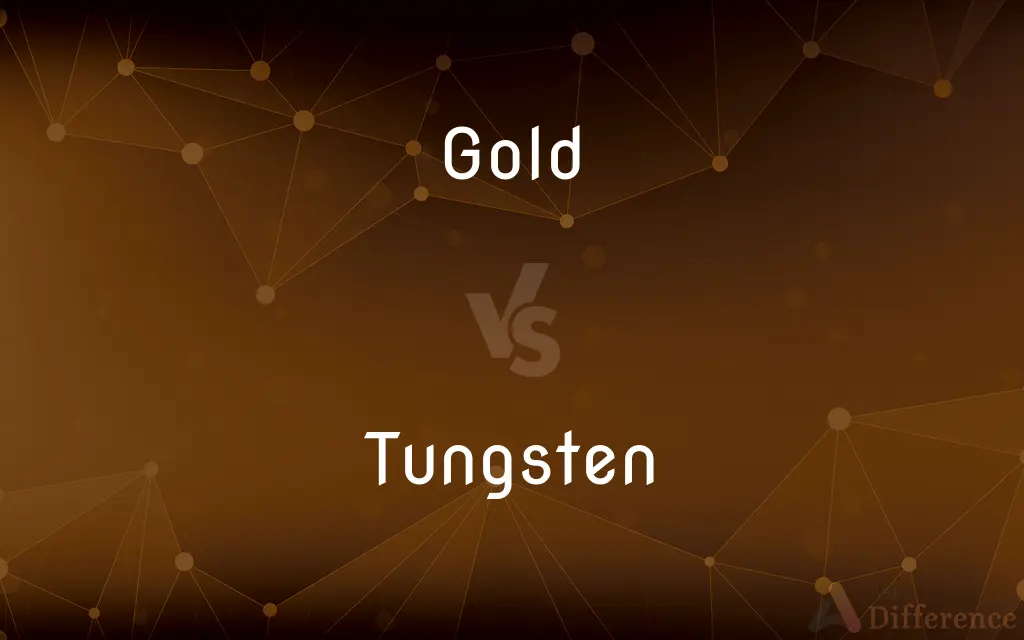Gold vs. Tungsten — What's the Difference?
Edited by Tayyaba Rehman — By Maham Liaqat — Updated on May 4, 2024
Gold is a highly valuable, soft metal known for its malleability and distinct yellow color, while tungsten is extremely hard, has a high melting point, and is often used in industrial applications.

Difference Between Gold and Tungsten
Table of Contents
ADVERTISEMENT
Key Differences
Gold is prized in jewelry and investment due to its aesthetic appeal and resistance to tarnish, whereas tungsten is valued for its robustness and high melting point, making it ideal for industrial uses.
The market value of gold is significantly higher, reflecting its status as a precious metal and an investment commodity, while tungsten's value is tied more to its industrial applications.
Gold is chemically inert and does not easily react with other elements, making it stable and desirable for electronics and jewelry, while tungsten, though also quite inert, is primarily used where strength and high-temperature resistance are required.
Gold can be easily shaped and stretched, making it perfect for detailed craftwork in jewelry, whereas tungsten's extreme hardness makes it suitable for applications like cutting tools and abrasives.
Gold is found naturally in its metallic form and is mined from the earth, primarily from veins and alluvial deposits, whereas tungsten is usually extracted from ores like wolframite and scheelite.
ADVERTISEMENT
Comparison Chart
Appearance
Bright yellow color
Grayish-white, lustrous
Hardness
Soft (2.5–3 Mohs scale)
Very hard (7.5 on the Mohs scale)
Melting Point
1064 °C
3422 °C
Primary Uses
Jewelry, investment
Industrial applications, tools
Market Value
High due to rarity
Lower, industrial value
Compare with Definitions
Gold
Often alloyed with other metals to increase hardness for jewelry use.
14 karat gold is 58.3% gold mixed with other metals.
Tungsten
Used to make filaments for light bulbs and electronic devices.
Tungsten filaments are crucial for the production of incandescent light bulbs.
Gold
Known for its excellent conductivity and resistance to corrosion.
Gold is often used in high-end electronics for reliable performance.
Tungsten
Known for having the highest melting point of all metals.
Tungsten's melting point makes it suitable for high-temperature applications.
Gold
A precious metal used extensively in jewelry and investments.
The price of gold fluctuates based on global market conditions.
Tungsten
Increasingly used in jewelry for its durability and unique look.
Tungsten rings are popular among those seeking a more durable alternative to traditional metals.
Gold
Gold is mined and refined from ore deposits.
Gold mining is a major industry in several countries.
Tungsten
Sourced primarily from mineral ores like scheelite and wolframite.
Tungsten mining focuses on extracting valuable tungsten ores.
Gold
Historically used as a standard for monetary systems.
The gold standard was once widely used in international finance.
Tungsten
Tungsten carbide is an important industrial material.
Tungsten carbide is used in making cutting tools for machining.
Gold
Gold is a chemical element with the symbol Au (from Latin: aurum) and atomic number 79, making it one of the higher atomic number elements that occur naturally. In a pure form, it is a bright, slightly reddish yellow, dense, soft, malleable, and ductile metal.
Tungsten
Tungsten, or wolfram, is a chemical element with the symbol W and atomic number 74. Tungsten is a rare metal found naturally on Earth almost exclusively as compounds with other elements.
Gold
A yellow precious metal, the chemical element of atomic number 79, used especially in jewellery and decoration and to guarantee the value of currencies.
Gold earrings
Tungsten
A hard, brittle, corrosion-resistant, gray to white metallic element extracted from wolframite, scheelite, and other minerals, having the highest melting point and lowest vapor pressure of any metal. Tungsten and its alloys are used in high-temperature structural materials and wear-resistant tools and machine parts; in electrical elements, notably lamp filaments; and in instruments requiring thermally compatible glass-to-metal seals. Atomic number 74; atomic weight 183.84; melting point 3,422°C; boiling point 5,555°C; specific gravity 19.3 (20°C); valence 2, 3, 4, 5, 6. Also called wolfram. See Periodic Table.
Gold
A deep lustrous yellow or yellow-brown colour
Her eyes were light green and flecked with gold
Tungsten
A rare metallic chemical element (symbol W, from Latin wolframium) with an atomic number of 74.
Gold
Coins or other articles made of gold
Her ankles and wrists were glinting with gold
Tungsten
A light bulb containing tungsten.
Gold
The bullseye of an archery target.
Tungsten
Scheelite, calcium tungstate
Gold
Symbol Au A soft, yellow, corrosion-resistant element, the most malleable and ductile metal, occurring in veins and alluvial deposits and recovered by mining, panning, or sluicing. A good thermal and electrical conductor, gold is generally alloyed to increase its strength, and it is used as a common monetary standard, in jewelry, for decoration, and as a plated coating on a wide variety of electrical and mechanical components. Atomic number 79; atomic weight 196.967; melting point 1,064.2°C; boiling point 2,856.0°C; specific gravity 19.3; valence 1, 3. See Periodic Table.
Tungsten
A rare element of the chromium group found in certain minerals, as wolfram and scheelite, and isolated as a heavy steel-gray metal which is very hard and infusible. It has both acid and basic properties. When alloyed in small quantities with steel, it greatly increases its hardness. Symbol W (Wolframium). Atomic weight, 183.6. Specific gravity, 18.
Gold
Coinage made of this element.
Tungsten
Scheelite, or calcium tungstate.
Gold
A gold standard.
Tungsten
A heavy gray-white metallic element; the pure form is used mainly in electrical applications; it is found in several ores including wolframite and scheelite
Gold
Money; riches.
Gold
A light olive-brown to dark yellow, or a moderate, strong to vivid yellow.
Gold
Something regarded as having great value or goodness
A heart of gold.
Gold
A medal made of gold awarded to one placing first in a competition, as in the Olympics
Won 9 golds in 13 events.
Gold
Having the color of gold.
Gold
(uncountable) A heavy yellow elemental metal of great value, with atomic number 79 and symbol Au.
Gold
A coin or coinage made of this material, or supposedly so.
The pirates were searching for gold.
Gold
(uncountable) A deep yellow colour, resembling the metal gold.
Gold
(countable) The bullseye of an archery target.
Daniel hit the gold to win the contest.
Gold
(countable) A gold medal.
France has won three golds and five silvers.
Gold
(figuratively) Anything or anyone that is very valuable.
That food mixer you gave me is absolute gold, mate!
Gold
A grill jewellery worn on front teeth made of gold.
Gold
Made of gold.
A gold chain
Gold
Having gold of gold.
Gold sticker
Gold socks
Gold
(of commercial services) Premium, superior.
Gold
Of a musical recording: having sold 500,000 copies.
Gold
In a finished state, ready for manufacturing.
Gold
To appear or cause to appear golden.
Gold
Of or referring to a gold version of something
Gold
An old English name of some yellow flower, - the marigold (Calendula), according to Dr. Prior, but in Chaucer perhaps the turnsole.
Gold
A metallic element of atomic number 79, constituting the most precious metal used as a common commercial medium of exchange. It has a characteristic yellow color, is one of the heaviest substances known (specific gravity 19.32), is soft, and very malleable and ductile. It is quite unalterable by heat (melting point 1064.4° C), moisture, and most corrosive agents, and therefore well suited for its use in coin and jewelry. Symbol Au (Aurum). Atomic weight 196.97.
Gold
Money; riches; wealth.
For me, the gold of France did not seduce.
Gold
A yellow color, like that of the metal; as, a flower tipped with gold.
Gold
Figuratively, something precious or pure; as, hearts of gold.
Gold
Coins made of gold
Gold
A deep yellow color;
An amber light illuminated the room
He admired the gold of her hair
Gold
A soft yellow malleable ductile (trivalent and univalent) metallic element; occurs mainly as nuggets in rocks and alluvial deposits; does not react with most chemicals but is attacked by chlorine and aqua regia
Gold
Great wealth;
Whilst that for which all virtue now is sold, and almost every vice--almighty gold
Gold
Something likened to the metal in brightness or preciousness or superiority etc.;
The child was as good as gold
She has a heart of gold
Gold
Made from or covered with gold;
Gold coins
The gold dome of the Capitol
The golden calf
Gilded icons
Gold
Having the deep slightly brownish color of gold;
Long aureate (or golden) hair
A gold carpet
Common Curiosities
How is tungsten typically extracted and processed?
Tungsten is extracted from ore minerals like wolframite and scheelite through processes that include crushing, grinding, and chemical treatment to produce tungsten powder.
Can both gold and tungsten be recycled?
Yes, both metals are recyclable. Gold is frequently recycled from old jewelry and electronics, while tungsten is often reclaimed from scrap metal.
What determines the quality of gold and tungsten?
Gold quality is determined by its purity, expressed in karats, with 24 karats being pure gold. Tungsten quality is assessed by its purity and the grain size of the metal or carbide powders.
What properties make gold so valuable?
Gold's value comes from its rarity, intrinsic beauty, malleability, non-corrosive nature, and historical significance as a form of currency and store of value.
What safety considerations are there when working with tungsten?
Working with tungsten, especially in powder form, requires precautions against inhalation and skin contact, as it can pose health risks.
Are there any common alloys or compounds of gold used industrially?
Gold is commonly alloyed with metals like silver, copper, and nickel to increase its hardness and suitability for various industrial applications, including dental alloys and electronics.
How do the physical properties of gold affect its use in electronics?
Gold's excellent electrical conductivity and resistance to oxidation make it highly effective for use in high-reliability electrical connectors and circuit board applications.
How do global markets affect the price of gold and tungsten?
Global markets affect gold prices through investment demand and economic conditions, while tungsten prices are influenced by industrial demand and supply chain dynamics.
What are some specific industrial applications of tungsten?
Tungsten is used in applications requiring high temperature resistance and durability, such as in aerospace for rocket engine nozzles, in welding, and as a catalyst in chemical manufacturing.
How are the environmental impacts of mining gold and tungsten mitigated?
Mitigation efforts include restoration projects, pollution controls, and adopting more sustainable mining techniques to reduce environmental damage.
What are the differences in mining techniques for gold and tungsten?
Gold mining often involves placer mining, dredging, and hard rock mining, focusing on extracting native gold. Tungsten mining is primarily from ore, requiring extensive chemical processing to extract the metal from its ores.
What historical uses have gold and tungsten had?
Historically, gold has been used for coinage, jewelry, and art, dating back thousands of years. Tungsten has been used for its hardness in tools and weaponry since its discovery as a distinct element in the 18th century.
What are the melting points of gold and tungsten, and why does it matter?
Gold melts at 1064 °C and tungsten at 3422 °C. These properties matter because they affect how each metal is processed and used in various technologies.
What is the role of gold and tungsten in modern technology?
Gold is vital in modern technology for its conductive properties, particularly in precision electronics, while tungsten is crucial in wear-resistant materials and components that must withstand extreme conditions.
Are there any synthetic alternatives to gold and tungsten?
There are no synthetic alternatives that fully replicate all properties of gold or tungsten, though research continues into materials that could substitute or mimic certain aspects for specific applications.
Share Your Discovery

Previous Comparison
Appease vs. Please
Next Comparison
Capris vs. CulottesAuthor Spotlight
Written by
Maham LiaqatEdited by
Tayyaba RehmanTayyaba Rehman is a distinguished writer, currently serving as a primary contributor to askdifference.com. As a researcher in semantics and etymology, Tayyaba's passion for the complexity of languages and their distinctions has found a perfect home on the platform. Tayyaba delves into the intricacies of language, distinguishing between commonly confused words and phrases, thereby providing clarity for readers worldwide.













































